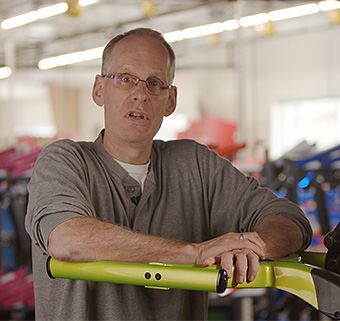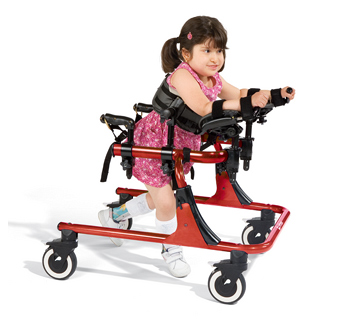Designing the Rifton Activity Chair
| March 2012 We have been making chairs for children with disabilities since the1970’s. Our first production models, though unique at the time, were primitive – plywood boxy frames covered with slots and knobs for adjustment. Over the years, as therapists’ input and suggestions flowed in, we continued tinkering and modifying the basic idea.
We have been making chairs for children with disabilities since the1970’s. Our first production models, though unique at the time, were primitive – plywood boxy frames covered with slots and knobs for adjustment. Over the years, as therapists’ input and suggestions flowed in, we continued tinkering and modifying the basic idea.
Then about ten years ago we introduced the Rifton Seating System, our first serious attempt to design a special needs chair from the ground up. This chair carried us (and our customers) for a decade, but new ideas, suggestions for changes, and even complaints continued to flow from therapists who were using it. (Therapists love giving design input!) And at Rifton we’re obsessive about recording every suggestion we receive from the field.
About four years ago it became clear that we needed to start all over again with our seating line. We formed a product design team of three members, and I was designated team leader. We embarked on a series of field visits that took us all over the northeastern United States and even to Europe where we met with therapists and observed firsthand some of the difficulties they were experiencing, taking notes on what we heard and saw. Our goal was to understand as fully as possible all the problems before we launched into any product design and development activity. Often an important detail of what is a real issue is not articulated but can be observed while working with a therapist in trying to get a child properly positioned in a chair.
We also conducted a phone survey, scheduling conference calls with therapists in Texas, California, and other parts of the country that were more than a few hours’ drive from our headquarters in New York. After working through the input we had gathered we decided we wanted more information. We sent out an invitation to participate in an on-line survey. Over three hundred therapists responded in detail. We were thrilled and inspired by the depth of interest shown in our design project.
Raising the Bar for Disability Design Standards
 A picture of what we needed to accomplish began to emerge. At Rifton we use a design discipline called Strategic Design which gives us the tools to evaluate and rate the design input. Through this methodology we determined fairly early that we wanted to separate the seat from the base so that we could offer options that would meet the needs of children needing minimal support up to children and adults who needed full support. We worked through the mechanical details and developed design prototypes of what we thought would work well. Each revision of the prototypes required additional field testing and input from therapists.
A picture of what we needed to accomplish began to emerge. At Rifton we use a design discipline called Strategic Design which gives us the tools to evaluate and rate the design input. Through this methodology we determined fairly early that we wanted to separate the seat from the base so that we could offer options that would meet the needs of children needing minimal support up to children and adults who needed full support. We worked through the mechanical details and developed design prototypes of what we thought would work well. Each revision of the prototypes required additional field testing and input from therapists.
One critical goal (which is fundamental to all Rifton products) was to design a product for people with disabilities that would enhance activity and motion. Accordingly the Activity Chair is designed with many support options to provide support while allowing as much freedom of motion as possible. We placed an emphasis in forward leaning, dynamic seating, and ease of transfer to standing.
Before making the commitment to tooling up for our design, we decided that we needed to call in the experts. We invited seven therapists and seating specialists from around the country that we felt gave us a good representation of our customer base. We spent a full day together, going over every detail and adjustment on the chairs. A number of suggestions and additional requests came out of this meeting, some of which required some fairly deep changes to our product. At the time it was actually a bit discouraging, but over the next three months we found our way through the list of suggestions and changes, and the results were worth every minute.
Safe, Quality Products Designed for People with Disabilities
 At Rifton we like to ensure the quality of our product by doing as much of the production process ourselves as possible, right here in New York State. For the Activity Chair this required making over 100 new injection molds to make the plastic parts that enable tool free adjustments. Welding jigs, assembly jigs and fixtures had to be developed and tested.
At Rifton we like to ensure the quality of our product by doing as much of the production process ourselves as possible, right here in New York State. For the Activity Chair this required making over 100 new injection molds to make the plastic parts that enable tool free adjustments. Welding jigs, assembly jigs and fixtures had to be developed and tested.
Throughout the whole product design process there is a lot of testing that needs to happen. From Rifton we strive to have our products as durable, trouble free, and safe as possible. Every major component needs to go through a battery of tests to try to replicate the life cycle of a typical special needs product in the field. When we say a product has a maximum working load of 150 pounds (like the medium Activity Chair) we want to know we can stand behind that number. But that means testing for a 150-pound child with high muscle tone who likes to rock violently in his chair for up to six hours a day. No easy assignment!
The most rewarding part of the design process comes at the end when we make our final round of field trips just before going into production. I’ll never forget watching a little girl in New Jersey smile when she had access to a sink for the first time! Or the appreciation from the teacher who could quickly position her child with special needs to join her peers for circle time at floor level.
We invite you to learn more about the product design features of the Small Rifton Activity Chair and the Large Rifton Activitiy Chair.
Thanks to all of you who helped us understand what we needed to do for this design project. Please keep the feedback flowing.



